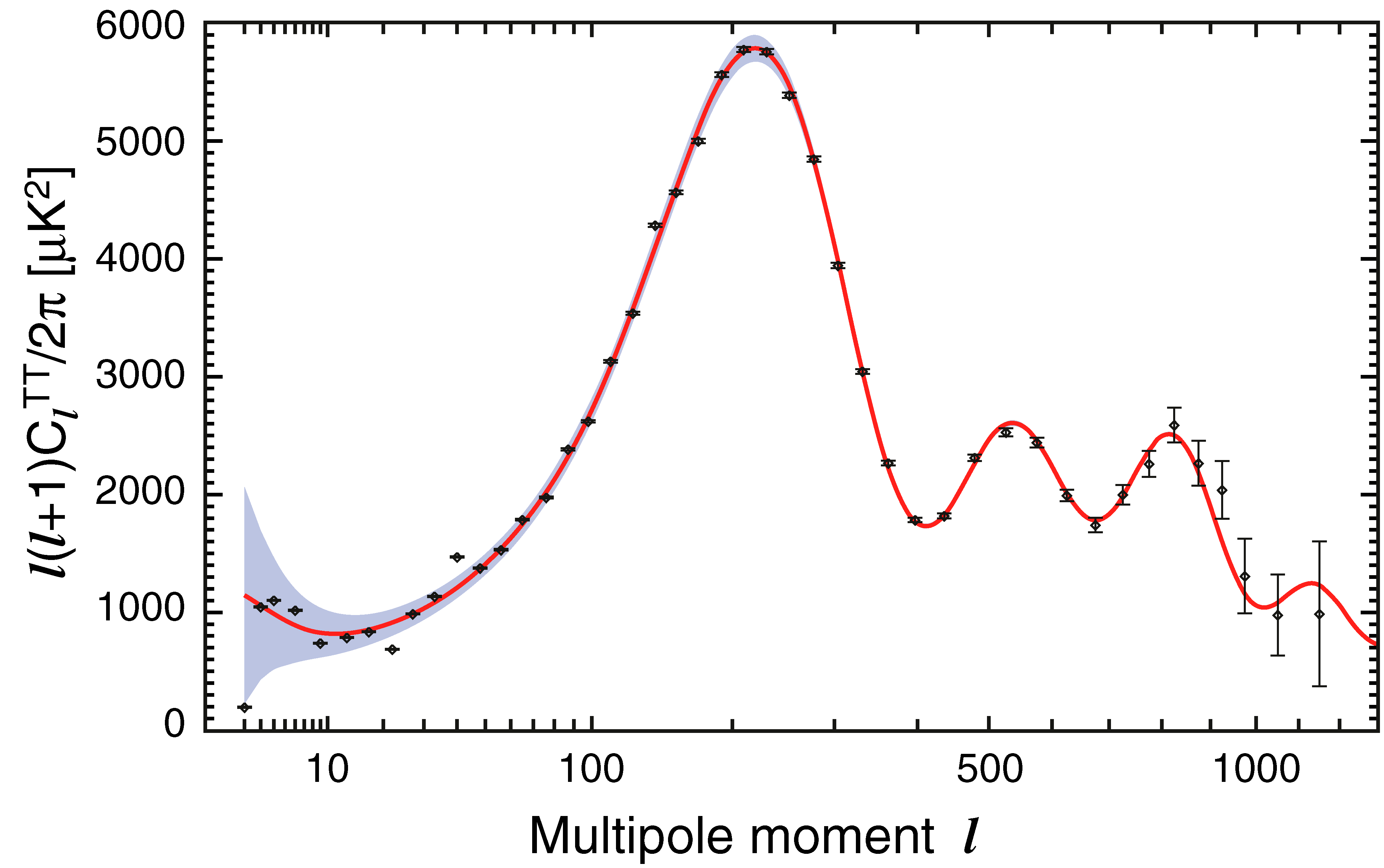
WMAP Version (2003)

Temperature variations of the cosmic background radiation as measured by WMAP.
I'm a
That column was published several
years ago and is available
on the
The idea of synthesizing the Big Bang
sound fascinated me. It ran

Plot of the multipole moments of the CMB from the WMAP Collaboration
My PC has a good sound card and a substantial sub-woofer, so it reproduced the .wav file well. When I ran the program for the first time and the sound started in my office, our two male Shetland Sheepdogs, Alex and Lance, came running into the room, barking with agitation. After they had looked around and determined that nothing terrible was happening, they lay down on the floor and listened attentively, giving the Sheltie Stare to my sub-woofer.
My Mathematica program
(or notebook) combines the WMAP
measured frequencies, appropriately
After I produced the .wav file, I E-mailed a copy to Daniel. His mother reports that his science project was a great success. I also linked the file to my BOOMERanG column and mentioned it to my daughter, Kathryn, who put it on her blog. I also mentioned it to Marcus Chown, who writes for New Scienist. He wrote a piece about it, and it was publicized in a press release about their new issue. The result was an amazing media explosion. The story was picked up by newspapers and news services around the world, including Aljazeera, the Telegraph (UK), Ananova (UK), news.com.au (Australia), The National Post (Canada), EurekaAlert!, The Mirror (UK), The Australian, The Brisbane Courier Mail, and The Frankfurter Allgemeine (Germany). It was also the feature front page story in the Turkish newspaper Sabah, crowding out the California fires. I was interviewed by three different parts of the BBC in the same 24 hour period, and I did several other radio interviews including a "Living on Earth" segment for National Public Radio. Many thousands of file requests hit our local web server, which was making the audio file available, and filled its hard disk, causing an ugly system crash. We had to move the file to a more robust system to deal with the traffic.
Originally I produced only one Sound of the Big Bang file, which had a duration of 100 seconds. However, in response to various requests I have produced files with more durations, including 20 seconds, 50 seconds, 100 seconds, 200 seconds, and 500 seconds. I still recommend the 100 second file, but the others are available. These audio files can be downloaded and used for any purpose, provided the text "(c) John G. Cramer - 2003" is used in text related to the file. References to my website, my Analog Columns, and my two hard science fiction novels Twistor and Einstein's Bridge are also encouraged and would be appreciated.
Here are the answers to two recurring questions that were asked repeatedly following the New Scientist article:
(1) The Big Bang Sound in the
simulation is derived from the sound propagating as compression waves through
the plasma/hydrogen medium of the early universe some 100 to 700 thousand years
after the initial Big Bang. The
density of this medium was changing as the universe expanded, but should have
been considerably more dense than air on our little planet.
One does NOT need air to have sound, only some medium in which
compression/rarefaction waves can propagate.
(2) The VISIBLE radius of the universe at age 760,000 years is, of course, 760,000 light years. However, even at this early age the scale radius of the universe is already larger than its visible radius, with regions already out of causal contact. The SCALE radius of 18 million light years mentioned in the New Scientist article is an estimate based on assuming that the universe expands as time to the 2/3 power (as it would for a flat Robertson-Walker metric with zero cosmological constant) and propagating backwards 3/2 of the present visible radius of the universe to its scale radius at age 760,000 years.
John
G. Cramer
November 10, 2003